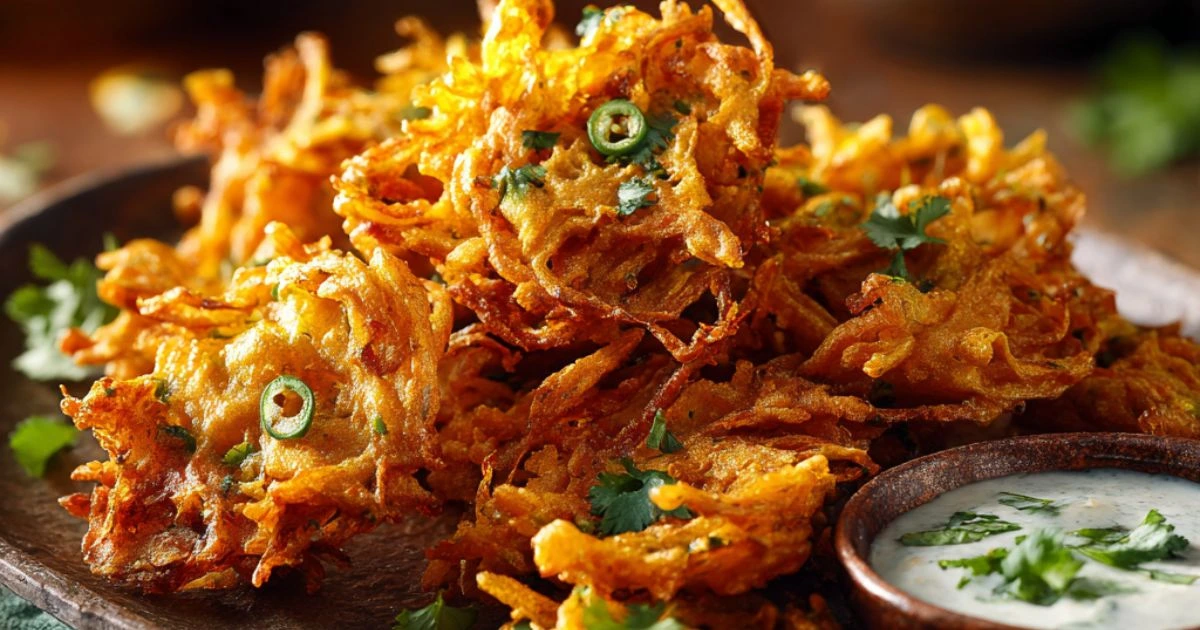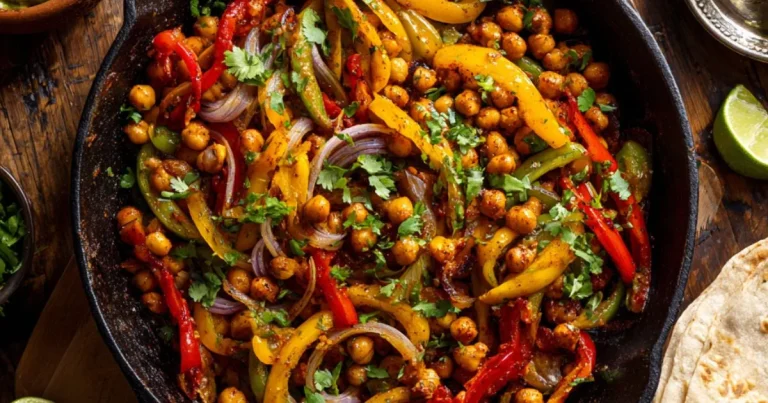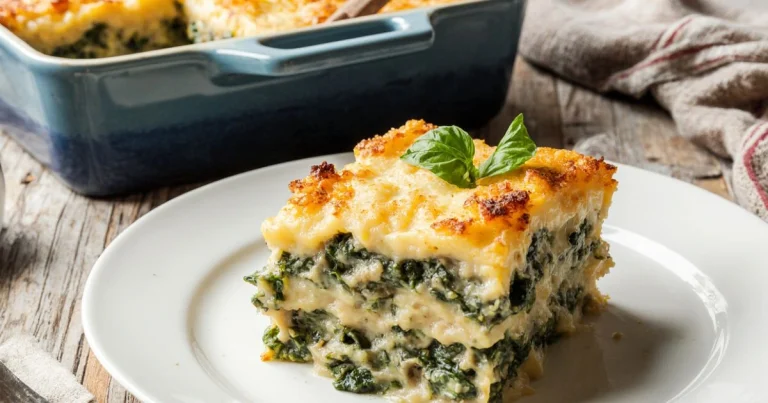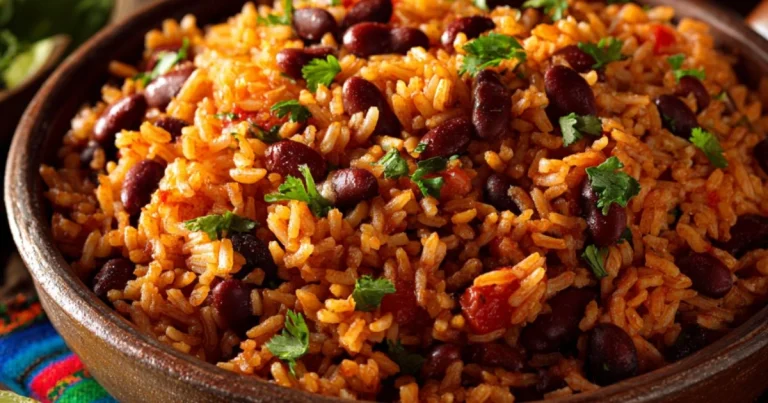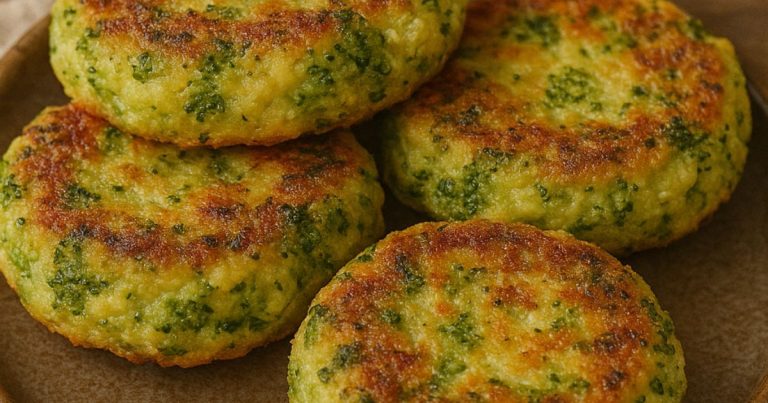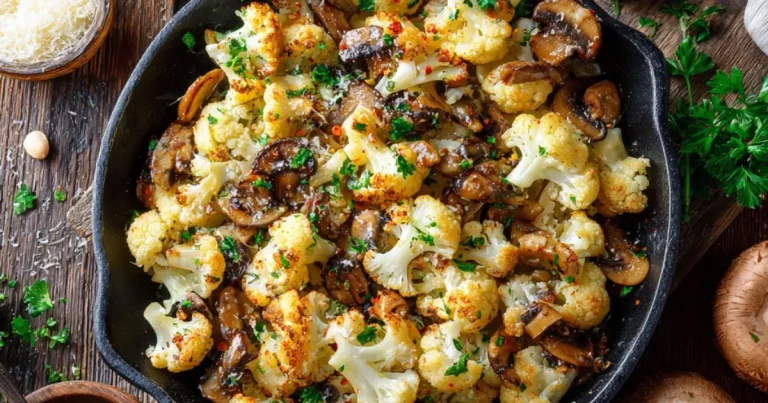Crispy Onion Bhajis: A Perfect Indian Snack
There’s something utterly satisfying about biting into a crispy onion bhaji — that crackling outer layer, the warm, spiced onion strands inside, and the irresistible aroma of cumin, coriander, and fried goodness. Whether you’re preparing them as an Indian appetizer, teatime snack, or part of a larger meal, onion bhajis (also known as onion pakoras or bhajjis) deliver on both flavor and texture.
These deep-fried delights are not just a takeaway favorite in the UK — they have rich roots in Indian street food culture, especially in regions like Maharashtra and Gujarat. According to BBC Good Food, they’ve been adapted in many home kitchens to cater to both traditional and modern tastes, including vegan and gluten-free versions.
But what exactly makes an onion bhaji crispy and unforgettable? In this complete guide, we’ll explore the origins, ingredients, techniques, and secrets that will help you master these Indian fritters at home. Want expert-level tricks? The team at Great British Chefs breaks down the perfect method for achieving that golden crunch.
What Is an Onion Bhaji?
Onion bhajis are a type of Indian fritter, made by coating thinly sliced onions in a spiced gram flour batter, then deep-frying them until golden and crispy. They’re known as kanda bhaji in Maharashtra, pakoras in North India, and bhajjis in the South.
Key features:
- Made from chickpea flour (besan), not wheat flour
- Spiced with turmeric, cumin, coriander, chili powder
- Typically served with mint chutney or raita
- Naturally gluten-free and often vegan
These savory treats have even been featured in the UK’s love affair with curry house starters. Read more about their cultural background on Wikipedia’s bhaji page.
Essential Ingredients for Crispy Perfection
To create truly crispy onion bhajis, every ingredient plays a key role — especially in the texture and flavor of the batter.
Must-Have Ingredients:
- Onions (red or yellow) – thinly sliced for quick, even frying
- Gram flour (besan) – the base of the batter
- Rice flour or cornflour – adds extra crunch
- Spices:
- Cumin seeds
- Coriander powder
- Turmeric
- Chili powder
- Asafoetida (optional, for depth)
- Fresh herbs: chopped coriander or curry leaves
- Salt – essential for both taste and drawing out onion moisture
- Oil – neutral oil with high smoke point (sunflower, peanut)
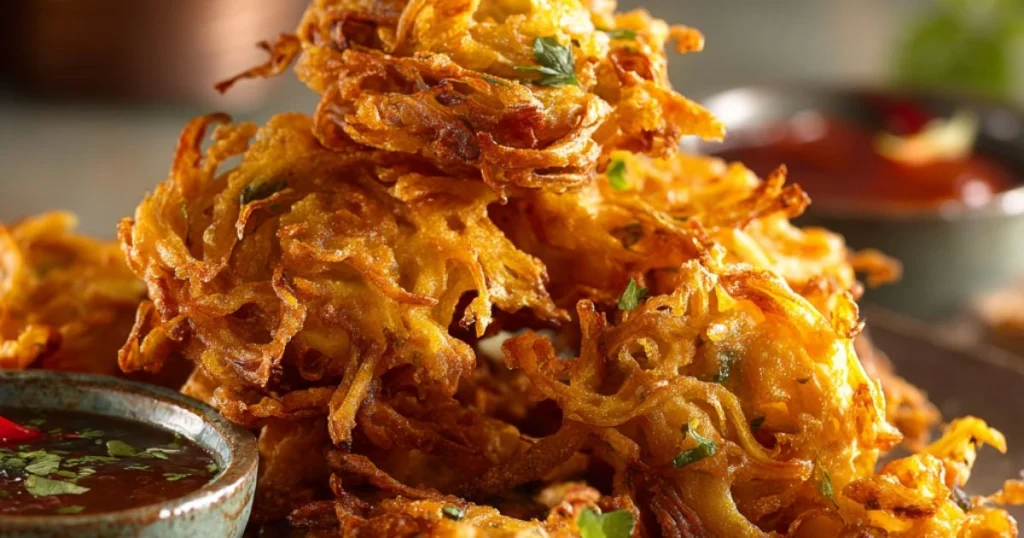
Equipment & Preparation Tips
You don’t need a deep fryer to make great bhajis at home. Here’s what helps:
- Deep, heavy-bottomed pan or wok
- Slotted spoon or spider ladle
- Paper towels for draining
- Thermometer (optional) to check oil temperature (aim for 170–180°C / 340–355°F)
Pro Prep Tips:
- Slice onions thin and evenly for faster, even frying
- Let sliced onions rest with salt to draw out water — this moisture helps bind the batter without needing to add water
- Mix dry ingredients first, then add onions
- Avoid adding excess water — a thick, sticky batter yields crispier bhajis
Step-by-Step Method to Make Crispy Onion Bhajis
Here’s a basic and adaptable method that works in most home kitchens:
1. Prepare the Onions
- Slice 2–3 medium onions thinly and place in a bowl
- Sprinkle with ½ tsp salt and let rest for 10–15 minutes
2. Make the Batter
- In a large bowl, combine:
- 1 cup gram flour
- 2 tbsp rice flour (for crispness)
- 1 tsp cumin seeds
- ½ tsp turmeric
- 1 tsp chili powder
- ½ tsp coriander powder
- Add the rested onions (including their moisture) to the dry mix
- Mix until the batter coats the onions without being runny
3. Fry the Bhajis
- Heat oil in a deep pan (170–180°C / 340–355°F)
- Scoop small portions (about a tablespoon) and drop gently into hot oil
- Fry for 4–5 minutes, turning occasionally until golden brown
- Remove and drain on paper towels
What Makes Bhajis Extra Crispy?
To get that addictive crunch, focus on these elements:
- Use rice flour or cornflour — both help create a crispy shell
- Avoid too much water — moisture comes from the onions
- Hot oil is key — too cold = greasy; too hot = burned
- Don’t overcrowd the pan — it drops the oil temperature
Let the batter rest for 5 minutes before frying to help bind and improve texture.
Popular Bhaji Variations
While the classic crispy onion bhaji is beloved across India and beyond, there are countless regional variations and creative twists that add unique flavors and textures.
In Maharashtra, the dish is known as Kanda Bhaji, often made spicier with green chilies and served during monsoons with fried green chilies and chutney. In Gujarat, methi gota (fenugreek leaf fritters) offer a slightly bitter, herbaceous alternative, while in the South, bhajis might include sliced banana peppers (mirchi bhajji) or raw plantain.
Popular Variations:
- Mixed Vegetable Bhaji – Add grated carrot, cabbage, or zucchini for texture.
- Potato Bhaji – Combine onions with thinly sliced or grated potatoes for a heartier fritter.
- Spinach Bhaji – Add chopped spinach or fenugreek leaves for added nutrients.
- Air Fryer Bhajis – A healthier twist that maintains crispness with less oil.
- Baked Bhajis – Oven-baked at high heat for a low-oil version, ideal for batch cooking.
No matter the variation, the key to great bhajis remains the same: balanced spices, gram flour batter, and a method that ensures crispy texture with tender, flavorful insides.
Serving Ideas & Dips
Onion bhajis shine brightest when paired with the right dips and sides that enhance their crispy texture and bold spices. Traditionally served as a starter or Indian street snack, they’re equally perfect at teatime or alongside a larger meal.
Popular Accompaniments:
- Mint chutney – Cool and refreshing, balances the heat
- Tamarind sauce – Sweet and tangy, adds contrast
- Mango chutney – Fruity with a kick, a classic choice
- Yogurt raita – Cucumber or mint raita cools the palate
Serve crispy onion bhajis on a platter with lemon wedges, fresh coriander, and a sprinkle of chaat masala for an extra punch. They pair wonderfully with masala chai for a cozy tea-time treat or as part of a thali meal with curries, rice, and naan.
Whether entertaining guests or indulging solo, bhajis are always better with dips!
Storage, Reheating & Freezing Tips
While crispy onion bhajis are best enjoyed fresh, you can still keep leftovers tasting great with the right techniques.
Storage:
- Store in an airtight container at room temperature for up to 24 hours.
- For longer storage, refrigerate for up to 2 days.
Reheating:
- Oven or air fryer at 180°C (355°F) is ideal — 5–8 minutes restores crispiness.
- Avoid the microwave, as it makes bhajis soggy.
Freezing:
- Flash freeze cooked bhajis on a tray, then transfer to freezer bags.
- Reheat from frozen in the oven or air fryer — no need to thaw.
To maintain that golden crunch, always reheat bhajis in dry heat — never steam or microwave. crispness.
Troubleshooting: Common Bhaji Mistakes
Making crispy onion bhajis can sometimes be tricky. Here’s how to fix common issues:
- Soggy bhajis: Oil temperature too low or batter too wet. Use a kitchen thermometer to keep oil at 170–180°C (340–355°F) and avoid adding extra water—onion moisture is enough.
- Bhajis falling apart: Batter is too loose or onions aren’t coated properly. Add a bit more gram flour and mix well.
- Burnt outside, raw inside: Oil too hot. Lower the temperature and fry slower for even cooking.
- Bhajis sticking together: Slice onions thinly and separate strands before mixing batter.
- Not crispy enough: Add rice flour for extra crunch and fry in batches without overcrowding the pan.
Following these tips guarantees perfect crispy onion bhajis every time!
Nutrition & Dietary Info
- Naturally gluten-free (no wheat flour)
- Vegan-friendly (no eggs or dairy)
- Per bhaji: ~ 90–120 calories (fried)
- Lower fat versions possible with air-frying or baking
Use healthy oils and drain well on paper towels to reduce oil retention.
Why Everyone Loves Crispy Onion Bhajis
- Crunchy texture with a soft, savory center
- Packed with spices that warm you up
- Versatile as a snack, side, or starter
- Naturally vegan and customizable
- Affordable and easy to make in batches
Whether you’re cooking for friends or craving street food flavors at home, onion bhajis never disappoint.
FAQs
What’s the difference between a bhaji and a pakora?
Both are fritters, but “bhaji” often refers specifically to onion-based versions. “Pakora” is a broader term covering many vegetables.
Can I bake onion bhajis instead of frying?
Yes! Use a preheated oven at 200°C (400°F), lightly oil a tray, and flip halfway through.
How do I make my bhajis crispier?
Use rice flour, avoid excess moisture, and make sure your oil is hot enough (but not smoking).
Can I make them ahead?
You can prepare the batter and refrigerate, but fry just before serving for best texture.
Are they gluten-free?
Yes — as long as you stick to gram flour and avoid adding wheat flour.
How do I reheat bhajis?
Best in an oven or air fryer. Avoid microwaving as it softens the crust.
What onions are best?
Red onions for sweetness, yellow onions for a more pungent flavor. Slice thin!
Final Thoughts
Mastering the art of crispy onion bhajis is all about balancing texture, spice, and technique. Whether you’re deep-frying the traditional way or going for a baked or air-fried option, the secret lies in the batter consistency and heat control.
Try different variations, serve them with your favorite chutneys, and enjoy the comfort of one of India’s most beloved street snacks — made perfectly crispy in your own kitchen.

